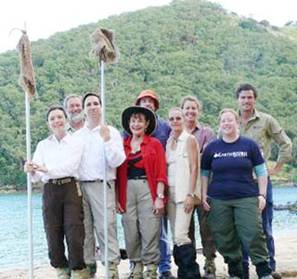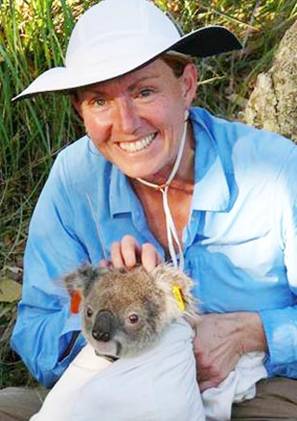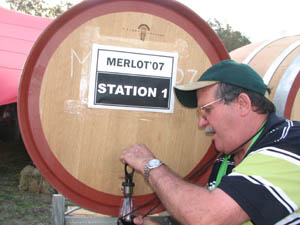| |
|
THANKS
A
very special thank you to Denise for printing the newsletter
each month and organising everything for Dawn and me to
get the newsletters ready for posting. Couldn't be done
without you! Doreen
|
| |
Koalas
ride the gale
This
has been a busy field year for me and the volunteers with
regard to koala research and – surprisingly this is the
first time I have had the peace of mind to prepare a newsletter
report. Even now I am writing this entry four days before
setting out on a 15 day expedition to western central
and north Queensland to get some sense of koala habitat
at the edge of the species range in tropical Australia.
Carmen, Shirley and Mary are traveling with me along with
visitors John and Barbara. I’ll talk about that trip after
I get back in mid-September. |
|
|
|
| |
|
|
| |
| |
St
Bees Island
The wet season
There
have been two Earthwatch supported field trips to St Bees
Island this year – in May and July. The May trip
is in autumn and just after our wet season. The wet season
had been intense and about 1.5 metres of rain fell in
February. It was fortunate that we had decided, in 2007,
not to run wet season trips as any work would have been
impossible. |
|
|
|
| |
|
|
Peter Berck has water running through his house. All the
rainforest streams and gullies carried large volumes of
water and the ground was saturated. In May we found many
small land slips and fallen trees. Our field equipment
was covered in mould. Despite the intense rain there was
no indication of adverse impacts on the koalas. The island
vegetation has responded to the rain and in May it was
difficult to find koalas in the thickened foliage.
|
| Trina and the spider. Orb-web spiders are
particularly common |
|
|
|
|
| |
|
|
| |
 |
|
This
wet season is ecologically important
being a decadal event. The flood flows scoured the valleys
and carried large volumes of litter and debris to the
bay and reorganising the beach dunes and tidal sand banks.
There has been a widespread seedling response and we can
expect to see a pulse of young trees, shrubs and vines
growing into the rainforests and eucalypt forests over
the next decade.
Despite
that there is still no evidence of regeneration of the
koala’s food species Eucalyptus tereticornis (Blue
Gum) and Eucalyptus platyphylla (Poplar Gum). |
| July team from top left: Doreen, Justine,
Trina, Rhonda*, Alistair, Geoff, John, Alex, Marita, Gayle.
From bottom left: Bik, Angie, Caleb*, John*
*indicates
a member of the National Parks Team |
TOP
|
|
|
| |
|
|
| |
| |
The goats
Queensland
Parks and Wildlife (service) commenced managing the island
goats last year after it became evident that
the vegetation was being severely graded. Goat browsing
was also considered as one possible factor limiting regeneration
of the koala food tree species. About 2,500 goats have
been removed so far. Despite that in the May and July
trips we found small groups of goats wherever we went
on the island. So it is possible that the remnant browsing
pressure is still sufficient to suppress Eucalyptus
regeneration. Goat control teams are continuing to visit
the island with the intent of removing all goats eventually.
There has been an exponential decline in goat numbers
and the project is now in a long tail of low detection
numbers for effort. It will be some years before goat
eradication is achieved.
We
can detect changes on the island, however. Firstly, the
island is much quieter. The constant background bleating
of nanny and kid is gone. It is no longer possible to
glance at a hillside and see 40 or so goats. Also the
degradation of the vegetation seems to have stopped. |
|
|
|
| |
|
|
| |

May team from left: Veronique, Alistair, Paul, Vicky,
Bill, Louann, Deborah, Jacque, Sean. The poles and flags
are used to guide the koala down the tree for capture |
TOP
|
Five
Earthwatch volunteers (an all USA group)
joined the team in May. We spent the time relocating the
koalas last tracked in October last year, servicing the
weather stations and data loggers and assisting Bill and
Sean to catch koalas and recover GPS data loggers. The
trip went well although the sand flies were frustrating
in the evening.
The
July trip was at capacity with 10 volunteers (five Australians,
5 from USA). The work focused on tracking the 13 radio
collared koalas to follow their response to the severe
weather experienced during this trip. The weather was
cold and windy at times. At the end of the first week
a three day gale blew across the island. We confined ourselves
to the houses for a day and a half when flying branches,
falling tree limbs and coconuts as well as buffeting wind
gusts and heavy rain made field activity dangerous. By
day the koalas' reaction to the adverse weather was not
what we expected. As the gale and rain intensified the
koalas moved to exposed trees and limbs – some leaving
their usual habitat in sheltered rainforest communities.
Once the rain and wind had passed and the sun reappeared
they returned to their use of sheltered trees and gullies.
Why would these animals place themselves at greatest exposure
to the elements rather than retreating to the most sheltered
aspects of their habitat available to them? In the last
few days of the trip a team from National Parks and Wildlife
arrived to monitor the vegetation recovery after goat
removal. |
|

|
|
|
|
| |
| |
|
 |
 |
Seasons
Greetings to all of you and may 2009 be a very happy,
safe and peaceful year. Alistair |
|
|
Deborah with a koala securely swaddled for
measuring.
TOP
|
|
|
| |
 |
|
“African
Rhythm and Reds on Tap”
was
a great way to spend 6 hours at Rumbalara
Winery in the Stanthorpe Region. With four large wooden
kegs of red wine and food all day, fresh chilled water
so we didn’t dehydrate and a main meal after 6pm. For
sweets three Belgium chocolate fountains and as many strawberries
as you could eat. We can recommend Rumbalara as a fine
winery and one to visit. While there ask for a taste
of Impy
Cream (when you take the link, skroll
to the bottom of the page to find Impy Cream) and
you won't be able to leave without taking a bottle or
two with you.
To
do with our web site, I’d like some feedback from readers
- their opinion on the opening page and subsequent layout.
I’ve tried the drop down menus and I don’t know if it
is the way to go, so some feed back would be appreciated
Cheers
Happy Christmas and Have a Safe New Year, Nick |
| |
|
|
|
|
| |
|
|
| |
|
|
| |
|
|
| |
TOP
|
|
|

